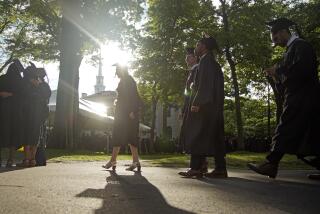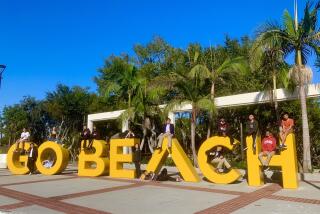Higher Learning: Many college students err on cost of education
Kevin Kou knows exactly how much he is paying to attend UCLA this year: $5,700, not counting federal and state grants, says the first-year student from Baldwin Hills. He recently checked the amount after logging onto a UCLA website.
Kou’s financial situation isn’t unique; 56% of UCLA undergraduates receive aid, but the fact that he actually knows the precise figure he pays may make him an outlier, at least according to a recent study by the Brookings Institution.
Researchers at the Washington, D.C.-based think tank conducted a survey of freshmen at a “selective four-year public university” in the northeast and found that barely over half were able to correctly say what they paid for their first year of college. And about half of students nationwide underestimated how much debt they are taking on for their education.
That lack of financial understanding could have dire consequences in the future, warned the researchers, Elizabeth J. Akers and Matthew M. Chingos.
Like starting a road trip without a good map, students who don’t understand what kind of financial situation they are getting into are “less equipped to make prudent decisions about what to study, how many courses to take and what kinds of jobs to pursue,” they wrote.
Worse, the conventional wisdom that a degree will be worth taking out loans helps lead to runaway tuition and fees, the researchers say. “There’s this belief that college is good and college is worth it at any cost, but if people continue to be uninformed about price, we end up in a place where it’s easy for tuitions to grow at a rapid pace,” Akers said.
Tuition, fees, room and board have increased by about $4,600 over the last decade, although the rate of financial aid has also increased during that time, studies have shown. Private school costs have increased by nearly $8,000 during that period.
Akers and Chingos polled students at the school, the name of which was kept confidential, and offered $10 to those who participated. About 600 students completed the survey, which had two questions: how much did you spend for your first year of school and how much debt have you incurred?
The researchers compared the students’ responses with their individual financial records at the school to measure how accurate they were. They found that 52% of students were able to correctly estimate their costs, a quarter underestimated, 17% overestimated, and 7% said they didn’t know.
Most students who attended the college had strong SAT scores, about 300 points higher than students from public schools, and come from more affluent families, according to the study, which also found that students with higher standardized test scores had a more accurate understanding of their debt.
The Brookings researchers conducted similar research with a national survey and found that most students underestimated how much debt they had.
Akers said she has begun to see signs that cost is becoming a greater factor in college decisions. The federal government will launch a rating score card next year that would allow families and others to compare colleges based on such measures as the percentage of low-income students receiving federal Pell grants, average tuition and student debt.
That ratings system “reflects a dramatic shift in thinking that gives the public more direction and doesn’t [emphasize] blind consumption of higher education,” Akers said.
Still, racking up a big bill to attend a name-brand school is a worthwhile investment, most studies show.
“That might be an effective strategy if you go to a top 5, top 20 school,” Akers said. “The problem is if you go to a non-selective school.”
Nearly 70% of graduating seniors last year finished their undergraduate education with nearly $28,500 in debt, according to a recent study by the nonprofit Institute of College Access and Success.
UCLA was ranked 23rd overall among all colleges in the latest U.S. News and World Report, and Kou said he likes attending the campus but worries about the future. Tuition at UC schools has been frozen the last three years, but, beginning next year, students could be hit with the first of five annual increases of up to 5%, depending on state funding.
“It’s so hard to plan when there’s so much uncertainty,” said Kou, who added that he would be reluctant to leave the Westwood campus. “But I can’t afford much more.”
Twitter: @latjasonsong
More to Read
Start your day right
Sign up for Essential California for news, features and recommendations from the L.A. Times and beyond in your inbox six days a week.
You may occasionally receive promotional content from the Los Angeles Times.







